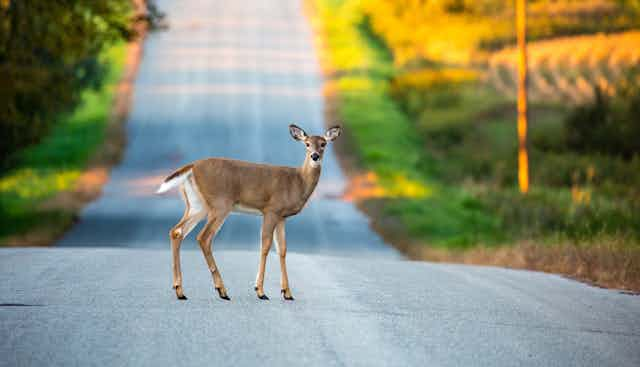At some point during the pandemic, Sars-CoV-2, the virus that causes COVID, spread from humans to white-tailed deer in the US.
In 2021, scientists revealed that 40% of white-tailed deer sampled in Michigan, Pennsylvania, Illinois and New York state had COVID antibodies.
Surveillance of these deer continues, and a new study by researchers at Ohio State University found that the virus is still spreading among the animals – and back to humans. And it is evolving rapidly.
The researchers looked at the prevalence of COVID in a small sample of white-tailed deer in north-eastern Ohio. The samples were taken between November 2021 and March 2022. From 1,522 nasal swabs, 163 tested positive for alpha and delta variants of COVID. The researchers also found that the virus had spread many times from humans to deer and from deer to humans (known as “spillover”).
Coronaviruses are covered in spikes and it is these spikes that latch on to our cells to gain entry and begin replicating. The particular part of our cells that the spikes latch on to is called the ACE2 receptor. This receptor is similar in deer and humans, and coronaviruses have lost little time in exploiting this.
Human contact with deer is common in parts of the US, where many millions of white-tailed deer live as wild, urbanised or farmed animals. In these habitats, deer may be exposed to human waste. They can carry bacteria with similar antimicrobial resistance patterns to local humans.

The Ohio researchers found that COVID multiplied and spread in deer over several months, causing no obvious illness or deaths in the animals. Migrating deer – males in particular – spread the virus as they moved across the county.
It is not known if other potential hosts such as skunks, squirrels or rodents contracted the virus too, but spread from deer back to humans was seen. How this exchange happened, though, is unclear.
Deer sampled on Staten Island, New York, over the same period showed evidence of spillover infection from humans by another COVID variant, omicron. Viral exchanges between communities and their deer are happening often.
Mutating three times faster in deer than in humans
By measuring changes in the COVID genomes in the deer using a new statistical method, the researchers in Ohio estimated that the rate of COVID mutation was three times greater than in humans. The types of genetic changes were not the same as those in human COVID. The mutations appeared to be adaptive responses that might have increased viral spread in its new deer hosts.
COVID showed early increases in its diversity in humans, too, which was perhaps more rapid in the first years after 2019.
Crucially, the spill-back of virus from deer to humans has not caused new human outbreaks that are making doctors lose sleep. Evolutionary changes in COVID in deer populations have not resulted in a virus that can evade our antibodies. So there is no current public health risk linked to this increased mutation rate.
As with humans, some deer are “super-spreaders”. Social network analysis shows this process in deer’s use of scraping sites, where males leave their scents to set up breeding groups. Human-made feeding or bait stations (for hunting) exacerbate the rate of viral spread, too.
White-tailed deer could be referred to as a new reservoir of COVID viruses. Animal reservoirs encompass a continuous process of viral division and change. Hosts impose selective pressures on viruses that influence the rate at which a virus’s genome changes. For example, influenza A evolves more rapidly in populations of birds or pigs than in people.
Probably, the lifespan of an infected animal, metabolic processes within its cells, immune actions, damage to viral RNA from host enzymes or other pathogens all force viral mutation. Whatever the reasons, these observations from Ohio raise the possibility that in those millions of white-tailed deer, COVID viruses might develop into a new strain or variant capable of spreading significant illness to humans.
Blood tests of UK deer in 2020-21 found no evidence of COVID in these animals. This could be because British deer species have distinctive ecological niches and COVID susceptibilities. But it is clear that this sort of ongoing surveillance provides valuable intelligence.

